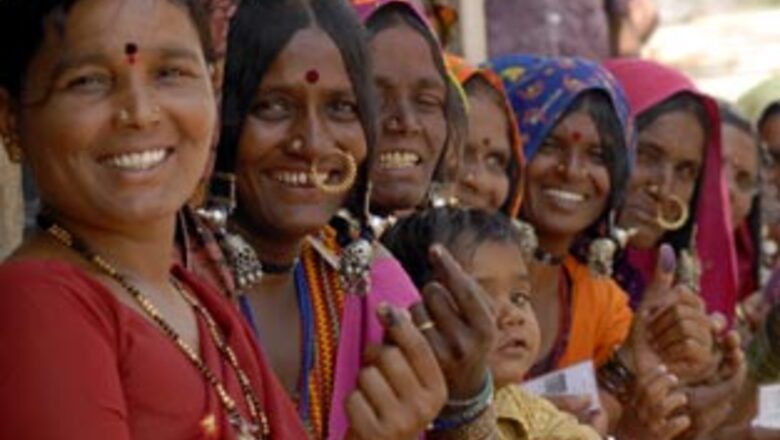
views
At first sight, the map of the second phase of polling has no political shape or pattern. Linear movement of security forces appears to have dictated the choice of constituencies in this biggest phase involving one-quarter of the country.
As you move southwards from the Red Corridor that polled in the first phase, you hit coastal Andhra, Rayalseema and the bordering areas of Karnataka.
On the east lies Coastal Orissa and on the West there is the vast territory of Marathwada, Western Maharashtra and Mahakoshal region of Madhya Pradesh. Up north, there is the remaining part of Jharkhand including Santhal Pargana. From Bhojpur on the borders of UP and Bihar that held election in the first phase, polling has proceeded westwards in UP and eastwards in Bihar. Add to it the remaining pockets in the North East, mainly the Brahmaputra valley in Assam, and you have the map of the second phase of polling.
A close look at the demographic composition of these constituencies shows a hidden pattern. This phase involves the rural heartland of India. In a country with 72 per cent rural population, every phase is bound to be predominantly rural, but this phase is disproportionately so.
Although metros like Bangaluru and Pune go to polls in this phase, the share of urban voters is only 22 per cent. As many as 102 of the constituencies that go to polls in this phase are rural in character (i.e. city dwellers are less than one-quarter in these constituencies). That accounts for 73 per cent constituencies of this phase, much higher than the national average of 63 per cent rural constituencies.
Farmers and agricultural labour constitute about 28 per cent of the population here. They are the largest though invisible ‘vote bank’ in this phase.
Source: CSDS Data Unit, matching of Census and the constituencies done by Dr. Sanjeer Alam Note: SC/ST seats refer to reserved seats. Rural seats are those with 75 per cent and above rural population. Muslims seats are those with 20 percent and above Muslim population to total population
One out of every three agricultural labour in the country could be casting his or her vote today. You would be right therefore to expect election campaign and democratic competition to be all about agrarian issues.
But that has not happened. A generation ago, there was at least the rhetoric of India living in her villages and an average Indian being a farmer. Now, the political class and the media has come together to manufacture a loud silence on the concerns of rural and agrarian India. The second phase of Lok Sabha polls is a study in why vast population in rural India does not become a politically salient constituency.
Read: Phase II Constituencies: Voting Pattern in Lok Sabha Elections 2004
PAGE_BREAK
MAHARASHTRA
The 25 constituencies that go to polls in Maharashtra today are clearly the best off areas in this rural heartland.
This phase comprises the sugar belt in Western Maharashtra, North Maharashtra, rural Konkan and most of Marathwada. If Congress retains some of its famous rural base, NCP represents the political clout of the better off farmers.
Over the last decade or more their control of sugar cooperatives and their hold over the Maratha vote has declined. Despite that the Congress and the NCP had picked up 14 of these seats in 2004 and increased their lead in the Vidhan Sabha elections held later that year. Political reports suggest that the Congress-NCP alliance has made gains in the first phase of polling, mainly in Vidarbha. They can add to these gains in Marathwada, thanks to weaning away of Maratha votes from Shiv Sena.
Yet there is a real possibility that they might squander most of these gains in Western Marathwada due to various forms of infighting: factional fights within the Congress and the NCP and of course the non-cooperation between the two allies. The BJP-Shiv Sena alliance might thus avoid a major setback from 2004. In any case the political dominance of the rich peasant in the state does not leave much space for the issues of the marginal farmers and agricultural labour.
KARNATAKA
In Karnataka too the long term process of the decline of rural political clout is likely to be reinforced in a different way. This first phase for Karnataka would involve 17 constituencies on the western border of the state, cutting across its traditional political regions.
The BJP, that has added peasants to its urban political base, would seek to snatch a few seats from the Congress which won all but one of its 8 seats last time in this area. The BJP state government is not terribly popular. Operation Kamal and the allegations of proximity to the mining lobby have dented it more than any fallout of Mangalore incident.
Yet it is too early for voters’ anger to set in, especially in a Lok Sabha election. The Congress is still as faction ridden as it was during assembly elections. If the rural base of the Congress is subordinated to an urban oriented leadership, the JD(S) is also trying hard to go beyond its rural base. In Madhya Pradesh too the BJP would look to replicate its victory in the recent assembly elections. They led in all but one of the 13 constituencies in the tribal dense belt that goes to polls today. The popularity of Shivraj Singh Chouhan and the continued fratricide within Congress works to the BJP’s advantage.
Read: Phase II Constituencies: Voting Pattern in Lok Sabha Elections 2004
ANDHRA PRADESH AND ORISSA
In political term, the keenest political battle would be fought in Andhra Pradesh and Orissa. Both the states have simultaneous elections to Lok Sabha and state assembly, leading to very high turnout last week. The specter of ‘hung assembly’ looms large in both the states, as the ruling parties have done poorly in the first phase. Credible political reports from Andhra Pradesh suggest that the Grand Alliance may have established a clear lead over the Congress in Telangana and north Coastal regions that went to polls last week. The second phase involves the rest of coastal Andhra and Rayalseema where the Congress is expected to do much better in a triangular contest with the TDP and the PRP, especially in Rayalseema. The real question is whether the Congress lead in the second phase would be enough to offset its deficit in the first and whether it would add up to a clear majority in the state assembly. The Congress leadership in Delhi would hope that the party would perform relatively better in the Lok Sabha election to cut its losses to minimum.
In Orissa too, the ruling BJD appears to have paid heavily in the first phase for its break up with the BJP. As the battle shifts in the second phase to the more developed and urbanized region of coastal Orissa, the BJD would hope to do very well in its traditional stronghold and wipe out the deficit it may have carried over. The trouble is that the BJP, earlier a non-factor in this part of Orissa, has managed to gather many ex-colleagues who Navin Patnaik’s has antagonized and discarded and is emerging as a serious third contender.
The BJD’s hopes of still securing a majority rest on the assumption that a triangular contest here would work to their advantage, just as it worked to the Congress’ advantage in the first phase. The keenness of political competition in both these states does not mean greater salience of the issues involving the villages. In Andhra Pradesh, it has meant race for freebies. In Orissa, low level of politicisation and absence of politically active peasant community continues to relegate issues of farmers.
The lie of the political land is radically different in the North East. In Assam, the ruling Congress is on a very sticky wicket. Its recovery among the Assamese speaking Hindus is under threat from the AGP-BJP alliance which appears to be working this time. From the other end, the Muslim outfit AUDF is taking away a big chunk of minority votes. Congress would be lucky to retain a few of its seats here. In Manipur, the ruling Congress hopes to retain the Inner Manipur seat while the ethnicisation of the quadrangular contest in Outer Manipur remains a challenge for everyone. The Left’s dominance appears to be unchallenged on both the seats of Tripura.
Read: Phase II Constituencies: Voting Pattern in Lok Sabha Elections 2004
PAGE_BREAK
UTTAR PRADESH AND BIHAR
In Uttar Pradesh and Bihar, the electoral contest is still about settling the primary questions of social dominance and securing basics of governance for most of the population. Both the states have reported very low turnout in the first phase.
In Bihar the grand social coalition of RJD-LJP is clearly on the back foot and appears to have faced reverses in the polling last week. Lalu-Paswan combine has a lot to lose in the second phase, as they won 10 of the 13 seats that go to poll today. Congress’ ability to draw some support among Muslims has added to the worries of the RJD supremo.
The NDA would expect to make significant gains in this phase on basis of the popularity of the Nitish government and the inroads he has made among lower OBCs and maha-dalits. In Uttar Pradesh this round too is mainly a contest between the SP and the BSP. The indications from the first round has both of them worried. Brahmin vote does not seem to have swung to the BSP, while SP faces a serious erosion among its Muslim votes. The BJP is reported to have done better than it was expected to. The SP needs to retain most of the 10 seats it won here, if the party is to remain relevant for the post-poll games in Delhi.
You would have expected a political contest for rural votes to result in some attention to the state of rural infrastructure, the fate of agricultural labour and the crisis of Indian agriculture. Instead all you get is some generalized talk of ‘development’ and lots of promises of freebies from cheap rice to colour TV and even cash transfer. You would have expected some serious debate on NREGA and the laon waiver for the farmers, the two big policy measures for rural India in recent times. Instead, you find that even the party that enacted these schemes is not really interested in promoting and publicizing these. India may still live in her villages. But rural India remains largely invisible in the largest festival of democracy.
Read: Phase II Constituencies: Voting Pattern in Lok Sabha Elections 2004
(Yogendra Yadav is Senior Fellow at CSDS and Editor of Samayik Varta. [email protected]. Research support for this article by Dr Sanjeer Alam and Himanshu Bhattacharya)




















Comments
0 comment